Technological Convergence and Innovation Pathways in Sustainable Logistics Systems: An Integrated Graph Neural Network and Main Path Analysis
Abstract
1. Introduction
2. Literature Review
2.1. Patent Text Mining Research
2.2. PatentNetwork Research
2.3. Technology Convergence Research
2.4. Main Path Analysis (MPA) Research
2.5. Research Gap and Contributions
3. Methodology
3.1. Data Collection and Preprocessing
3.1.1. Patent Data Collection
3.1.2. Patent Data Preprocessing
3.2. Patent–Keyword Matrix Construction
3.2.1. Representation of Patent Documents
3.2.2. TF–IDF Weighting
3.2.3. Patent–Patent Co-Occurrence Projection
3.2.4. Normalization of Edge Weights
- Jaccard Coefficient
- Association Strength (AS)
3.2.5. Network Sparsificationand Reproducibility
3.3. Graph Embedding via Variational Graph Auto-Encoder (VGAE)
3.3.1. Model Overview and Rationale
3.3.2. Feature Construction and Learning Process
3.3.3. Evaluation Framework
- Silhouette coefficient [81]: measures how similar each sample is to its own cluster compared with other clusters. Higher values indicate well-defined, compact clusters.
- Davies–Bouldin index (DBI) [82]: quantifies the average similarity between each cluster and its most similar neighbor. Lower DBI indicates less overlap and stronger separation.
- Calinski–Harabasz score (CH) [83]: evaluates the ratio of between-cluster to within-cluster variance. A higher CH implies distinct, well-separated clusters.
- Dunn index [84]: compares the minimum inter-cluster distance with the maximum intra-cluster distance. Larger values indicate that clusters are simultaneously compact and well separated.
- Weighted modularity Q [85]: measures the strength of community structure in the graph (higher values suggest well-formed communities).
- Conductance [86]: evaluates the fraction of edges crossing cluster boundaries (lower values indicate stronger internal connectivity).
- Mixing parameter (μ) [86]: represents the proportion of inter-cluster edges relative to all edges (lower μ indicates cohesive clusters).
3.3.4. Visualization and Interpretation
3.4. Main Path Analysis (MPA): Weight–Time Coupled Knowledge Flows
3.4.1. Graph Construction and Temporal Ordering
3.4.2. Edge-Level Time Metrics and Coupling
- Time per unit strength: , capturing the latency per structural intensity of a link.
- Weighted time: , capturing time burden adjusted by strength.
3.4.3. Global and Local Main Paths (SPLC-Based)
4. Results
4.1. Descriptive Statistics of Patent Dataset
4.2. Network Structure and Graph Embedding
4.3. Clustering Results and Technological Grouping
- Autonomous driving and perception systems—including steering, parking, and image-based assistive technologies (C0, C1, C3, C6, C10, C14, C25)
- Electrified and connected vehicle platforms—such as EV charging, power management, and hybrid control architectures (C4, C8, C24)
- Mobile robotics and logistics automation—encompassing AGV drive systems, unmanned vehicle operation, and robotic inspection (C12, C17, C19, C23)
- Information processing and industrial control systems—including inventory management, decision-support algorithms, and sensor integration (C16, C20, C22, C28, C29).
4.4. GlobalMain Path Analysis
- Early Phase (C13 → C0 → C3)—This initial segment represents the emergence of vehicle-centric control and perception systems, focusing on steering control, parking assistance, and image-based trajectory recognition. These clusters form the foundation of intelligent driving support technologies.
- Middle Phase (C26 → C17 → C29 → C25)—The intermediate section corresponds to the expansion of these foundations into autonomous and logistics-oriented applications, including method-driven control logic, unmanned transport systems, trailer guidance, and materials-handling optimization. This phase marks the operational deployment of autonomous technologies into practical mobility and logistics contexts.
- Late Phase (C27 → C9 → C23 → C15 → C8)—The final stage represents a convergence toward industrial robotics and electrified platforms, encompassing chassis automation, inspection robotics, articulated mechanisms, and EV battery management. This shift signifies the transformation from vehicle-specific control systems to integrated smart robotics and electrified mobility platforms.
- Lower-layer clusters (C13) represent the earliest innovation nodes.
- Middle layers (C26, C17, C29, C25) dominate, corresponding to the diffusion of automation and AGV-based control logic.
- Upper layers (C23, C15, C8) are concentrated, demonstrating the transition into robotics-driven and electrified solutions.
4.5. Methodological Validation
4.5.1. Structural Coherence
4.5.2. Temporal Alignment
4.5.3. Interpretability
4.5.4. Comparative Discussion
4.6. Empirical Cross-Validation
4.6.1. Policy-Level Consistency
4.6.2. Industry and Market Validation
4.6.3. Academic and Empirical Correspondence
4.6.4. Phase-Based Empirical Validation of Technological Evolution
4.6.5. Summary
5. Discussion and Implications
5.1. Empirical Insights
5.2. Policy Implications
6. Conclusions
Author Contributions
Funding
Institutional Review Board Statement
Informed Consent Statement
Data Availability Statement
Conflicts of Interest
Appendix A
| Cluster | Cluster Name | Representative Keywords |
|---|---|---|
| C0 | Steering & Travel Control Interfaces | selected drawing figure·steering control · travel control system |
| C1 | Autonomous Routing & Waypoint Planning | autonomous vehicle · set intermediate point · computer program therefor |
| C2 | Environmental Perception & Awareness | vehicle includes · present disclosure relates · acquiring environmental information |
| C3 | Vision-Based Trailer/ Maneuver Assistance | image data captured · image data · trailering assist system |
| C4 | EV Charging Hardware Modules | utility model relates · fixedly installed · charging small door |
| C5 | Two-Wheeler Accident Classification | two-wheeled vehicle · accident event involving · classifying an accident |
| C6 | Automated Parking Control Systems | parking control method · parking control device · target parking space |
| C7 | Reverse Trajectory Reconstruction | alt embedded image · embedded image file · reverse travel trajectory |
| C8 | EV Platform & Battery Early-Warning | electric vehicle · electric vehicle battery · early warning device |
| C9 | Vehicle Chassis/Body Modules | utility model discloses · fixedly connected · bottom plate |
| C10 | Mode Switching & Hybrid Control | manual driving mode · autonomous driving mode · control system |
| C11 | Active Tracking & Localization | vehicle body · tracking device based · active tracking device |
| C12 | Differential-Drive Mobile Robots | drive wheel · pivot axis · mobile robot drive |
| C13 | Parking Assistance & Space Detection | parking space · parking assistance device · parking assistance |
| C14 | In-Vehicle Computing & Obstacle Avoidance | vehicle computing system · blocking object avoidance · vehicle computing |
| C15 | Legged & Articulated Mechanisms | control method thereof · main driving assembly · legs torsion springs |
| C16 | Smart Inventory Management Systems | present invention relates · present invention · inventory management system |
| C17 | Unmanned Vehicle Operation Systems | unmanned moving body · moving body operation · body operation system |
| C18 | Hitch/Trailer Coupling Assistance | hitch assist system · sensing system configured · hitch assist |
| C19 | AGV Lifting & Transport Systems | latent lifting agv · side end face · agv traveling lifting |
| C20 | Generic Vehicle Control Algorithms | vehicle control device · control device vehicle · vehicle control method |
| C21 | Motor-Vehicle Systems & Software | motor vehicle · invention relates · computer program product |
| C22 | Weighted-Factor Decision Models | faktorbasierend auf · basierend auf einem · gewichtetenfaktorbasierend |
| C23 | Inspection Robots & Modular Drives | inspection robot · drive module · num inspection robots |
| C24 | Smart Steering Wheel Interfaces | steering wheel · functional zone · steering wheel comprising |
| C25 | Steering Angle Estimation & Trailer Sensing | steering angle · trailer flank object · vehicle steering angle |
| C26 | Pattern-Recognition Workflow Methods | method includes identifying · method includes · method includes determining |
| C27 | Legacy ICE Vehicle Procedures | betriffteinverfahren · erfindungbetrifftein · betriebenekraftfahrzeuge |
| C28 | Information Processing/ Acquisition Units | information processing device · information acquisition unit · information processing |
| C29 | Materials-Handling Vehicle Control | maximum vehicle acceleration · monitored vehicle acceleration · materials handling vehicle |
References
- Rejeb, A.; Rejeb, K.; Simske, S. Sustainability and Digital Transformation in Supply Chain and Logistics. Sustainability 2023, 15, 3384. [Google Scholar] [CrossRef]
- Centobelli, P.; Cerchione, R.; Esposito, E. Pursuing Supply Chain Sustainability through Innovation and Technology: A Systematic Literature Review. Sustainability 2020, 12, 7136. [Google Scholar] [CrossRef]
- Bag, S.; Wood, L.C.; Xu, L. Artificial Intelligence in Sustainable Logistics and Supply Chain Management: A Systematic Literature Review and Future Research Directions. Transp. Res. Part E Logist. Transp. Rev. 2020, 141, 102010. [Google Scholar] [CrossRef]
- Rejeb, A.; Rejeb, K.; Simske, S.; Keogh, J.G. Exploring Blockchain Research in Supply Chain Management: A Latent Dirichlet Allocation-Driven Systematic Review. Information 2023, 14, 557. [Google Scholar] [CrossRef]
- Dubey, R.; Gunasekaran, A.; Childe, S.J. Big Data Analytics and Artificial Intelligence Pathway to Operational Performance under the Effects of Environmental Dynamism. Int. J. Prod. Econ. 2019, 211, 301–313. [Google Scholar] [CrossRef]
- Winkelhaus, S.; Grosse, E.H. Logistics 4.0: A systematic review towards a new logistics system. Int. J. Prod. Res. 2020, 58, 18–43. [Google Scholar] [CrossRef]
- Demir, S.; Paksoy, T.; Kochan, C.G. Logistics 4.0: SCM in Industry 4.0 Era: Changing Patterns of Logistics in Industry 4.0 and Role of Digital Transformation in SCM. In Logistics 4.0; CRC Press: Boca Raton, FL, USA, 2020; pp. 15–26. [Google Scholar]
- Salton, G.; Buckley, C. Term-Weighting Approaches in Automatic Text Retrieval. Inf. Process. Manag. 1988, 24, 513–523. [Google Scholar] [CrossRef]
- Lee, C.; Kang, B.; Shin, J. Novelty-focused patent mapping for technology opportunity analysis. Technol. Forecast. Soc. Change 2015, 90, 355–365. [Google Scholar] [CrossRef]
- Curran, C.S. The Anticipation of Converging Industries: A Concept Applied to Nutraceuticals and Functional Foods. Technol. Forecast. Soc. Change 2013, 80, 15–24. [Google Scholar] [CrossRef]
- Kipf, T.N.; Welling, M. Semi-Supervised Classification with Graph Convolutional Networks. In Proceedings of the International Conference on Learning Representations (ICLR), Toulon, France, 24–26 April 2017. [Google Scholar]
- Wu, Z.; Pan, S.; Chen, F.; Long, G.; Zhang, C.; Philip, S.Y. A Comprehensive Survey on Graph Neural Networks. IEEE Trans. Neural Netw. Learn. Syst. 2021, 32, 4–24. [Google Scholar] [CrossRef]
- Hummon, N.P.; Doreian, P. Connectivity in a Citation Network: The Development of DNA Theory. Soc. Netw. 1989, 11, 39–63. [Google Scholar] [CrossRef]
- Caviggioli, F. Technology fusion: Identification and analysis of the drivers of technology convergence using patent data. Technovation 2016, 55, 22–32. [Google Scholar] [CrossRef]
- Lucio-Arias, D.; Leydesdorff, L. Main-path analysis and path-dependent transitions in HistCite™-based historiograms. J. Am. Soc. Inf. Sci. Technol. 2008, 59, 1948–1962. [Google Scholar] [CrossRef]
- Liu, J.S.; Lu, L.Y.; Ho, M.H.C. A note on choosing traversal counts in main path analysis. Scientometrics 2020, 124, 783–785. [Google Scholar] [CrossRef]
- Yu, D.; Sheng, L. Influence difference main path analysis: Evidence from DNA and blockchain domain citation networks. J. Informet. 2021, 15, 101186. [Google Scholar] [CrossRef]
- Liao, S.C.; Chou, T.C.; Huang, C.H. Revisiting the development trajectory of the digital divide: A main path analysis approach. Technol. Forecast. Soc. Change 2022, 179, 121607. [Google Scholar] [CrossRef]
- He, J.; Wang, Y. Patent-Based Analysis of China’s Emergency Logistics Industry Convergence. Sustainability 2023, 15, 4419. [Google Scholar] [CrossRef]
- So, J.; An, H.; Lee, C. Defining Smart Mobility Service Levels via Text Mining. Sustainability 2020, 12, 9293. [Google Scholar] [CrossRef]
- Pölzlbauer, G.; Auer, E. Applied patent mining with topic models and meta-data: A comprehensive case study. World Patent Inf. 2021, 67, 102065. [Google Scholar] [CrossRef]
- Huang, K.; Cai, M.; Xiao, Y. Identifying Key Technologies and Cluster Patterns in Intelligent Transportation Systems. Transp. Res. Rec. 2025, 2679, 833–859. [Google Scholar] [CrossRef]
- Lobanova, P.; Bakhtin, P.; Sergienko, Y. Identifying and visualizing trends in science, technology, and innovation using SciBERT. IEEE Trans. Eng. Manag. 2023, 71, 11898–11906. [Google Scholar] [CrossRef]
- Chikkamath, R.; Parmar, V.R.; Otiefy, Y.; Endres, M. Patent classification using bert-for-patents on USPTO. In Proceedings of the 2022 5th International Conference on Machine Learning and Natural Language Processing, Sanya, China, 16–18 December 2022; pp. 20–28. [Google Scholar]
- Zhu, C.; Motohashi, K. Identifying the Technology Convergence Using Patent Text Information: A Graph Convolutional Networks (GCN)-Based Approach. Technol. Forecast. Soc. Change 2022, 176, 121477. [Google Scholar] [CrossRef]
- Érdi, P.; Makovi, K.; Somogyvári, Z.; Strandburg, K.; Tobochnik, J.; Volf, P.; Zalányi, L. Prediction of Emerging Technologies Based on Analysis of the U.S. Patent Citation Network. Scientometrics 2013, 95, 225–242. [Google Scholar] [CrossRef]
- Bekamiri, H.; Hain, D.S.; Jurowetzki, R. Patentsberta: A deep nlp based hybrid model for patent distance and classification using augmented sbert. Technol. Forecast. Soc. Change 2024, 206, 123536. [Google Scholar] [CrossRef]
- Lee, J.S.; Hsiang, J. Patent classification by fine-tuning BERT language model. World Patent Inf. 2020, 61, 101965. [Google Scholar] [CrossRef]
- Sternitzke, C.; Bartkowski, A.; Schramm, R. Visualizing patent statistics by means of social network analysis tools. World Patent Inf. 2008, 30, 115–131. [Google Scholar] [CrossRef]
- Liu, D.R.; Shih, M.J. Hybrid-patent classification based on patent-network analysis. J. Am. Soc. Inf. Sci. Technol. 2011, 62, 246–256. [Google Scholar] [CrossRef]
- Kim, K.; Jung, S.; Hwang, J. Technology convergence capability and firm innovation in the manufacturing sector: An approach based on patent network analysis. R&D Manag. 2019, 49, 595–606. [Google Scholar]
- Curran, C.S.; Bröring, S.; Leker, J. Anticipating converging industries using publicly available data. Technol. Forecast. Soc. Change 2010, 77, 385–395. [Google Scholar] [CrossRef]
- Lee, S.; Kim, W.; Lee, H.; Jeon, J. Identifying the structure of knowledge networks in the US mobile ecosystems: Patent citation analysis. Technol. Anal. Strateg. Manag. 2016, 28, 411–434. [Google Scholar] [CrossRef]
- Kipf, T.N.; Welling, M. Variational graph auto-encoders. arXiv 2016, arXiv:1611.07308. [Google Scholar] [CrossRef]
- Hamilton, W.; Ying, R.; Leskovec, J. Inductive representation learning on large graphs. arXiv 2017, arXiv:1706.02216. [Google Scholar] [CrossRef]
- Jeong, Y.; Jang, H.; Yoon, B. Developing a Risk-Adaptive Technology Roadmap Using a Bayesian Network and Topic Modeling under Deep Uncertainty. Scientometrics 2021, 126, 3697–3722. [Google Scholar] [CrossRef]
- Wen, Z.; Fang, Y.; Wei, P.; Liu, F.; Chen, Z.; Wu, M. Temporal and heterogeneous graph neural network for remaining useful life prediction. IEEE Trans. Neural Netw. Learn. Syst. 2025, 36, 19748–19761. [Google Scholar] [CrossRef]
- Lu, D.; Chen, Y.; Sun, Y.; Wei, W.; Ji, S.; Ruan, H.; Yi, F.; Jia, C.; Hu, D.; Tang, K.; et al. Research Progress in Multi-Domain and Cross-Domain AI Management and Control for Intelligent Electric Vehicles. Energies 2025, 18, 4597. [Google Scholar] [CrossRef]
- Garikapati, D.; Shetiya, S.S. Autonomous Vehicles: Evolution of Artificial Intelligence and the Current Industry Landscape. Big Data Cogn. Comput. 2024, 8, 42. [Google Scholar] [CrossRef]
- Park, S.; Lee, S.J.; Jun, S. A Network Analysis Model for Selecting Sustainable Technology. Sustainability 2015, 7, 13126–13141. [Google Scholar] [CrossRef]
- Bhatt, P.C.; Hsu, Y.C.; Lai, K.K.; Drave, V.A. Technology Convergence Assessment by an Integrated Approach of BERT Topic Modeling & Association Rule Mining. IEEE Trans. Eng. Manag. 2025; manuscript accepted. [Google Scholar]
- Weidemann, C.; Mandischer, N.; van Kerkom, F.; Corves, B.; Hüsing, M.; Kraus, T.; Garus, C. Literature Review on Recent Trends and Perspectives of Collaborative Robotics in Work 4.0. Robotics 2023, 12, 84. [Google Scholar] [CrossRef]
- Su, W.H.; Chen, K.Y.; Lu, L.Y.; Huang, Y.C. Identification of Technology Diffusion by Citation and Main Paths Analysis: The Possibility of Measuring Open Innovation. J. Open Innov. Technol. Mark. Complex. 2021, 7, 104. [Google Scholar] [CrossRef]
- Khazali, A.; Al-Wreikat, Y.; Fraser, E.J.; Naderi, M.; Smith, M.J.; Sharkh, S.M.; Cruden, A.J. Sizing a Renewable-Based Microgrid to Supply an Electric Vehicle Charging Station: A Design and Modelling Approach. World Electr. Veh. J. 2024, 15, 363. [Google Scholar] [CrossRef]
- Zhou, S.; Liu, Y.; Liu, Y. A Market Convergence Prediction Framework Based on a Supply Chain Knowledge Graph. Sustainability 2024, 16, 1696. [Google Scholar] [CrossRef]
- Peng, M.; Chen, K.; Guo, X.; Zhang, Q.; Zhong, H.; Zhu, M.; Yang, H. Diffusion Models for Intelligent Transportation Systems: A Survey. arXiv 2025, arXiv:2409.15816. [Google Scholar] [CrossRef]
- Bahoo, S.; Cucculelli, M.; Qamar, D. Artificial Intelligence and Corporate Innovation: A Review and Research Agenda. Technol. Forecast. Soc. Change 2023, 188, 122264. [Google Scholar] [CrossRef]
- Hummon, N.P.; Doreian, P. Computational methods for social network analysis. Soc. Netw. 1990, 12, 273–288. [Google Scholar] [CrossRef]
- Verspagen, B. Mapping technological trajectories as patent citation networks: A study on the history of fuel cell research. Adv. Complex Syst. 2007, 10, 93–115. [Google Scholar] [CrossRef]
- Jiang, X.; Liu, J. Extracting the evolutionary backbone of scientific domains: The semantic main path network analysis approach based on citation context analysis. J. Assoc. Inf. Sci. Technol. 2023, 74, 546–569. [Google Scholar] [CrossRef]
- Yu, D.; Fang, A. The Knowledge Trajectory and Structure of the Supply Chain Integration: A Main Path and Cluster Analysis. J. Enterp. Inf. Manag. 2023, 36, 1056–1079. [Google Scholar] [CrossRef]
- Rejeb, A.; Rejeb, K.; Zailani, S.H.M.; Abdollahi, A. Knowledge Diffusion of the Internet of Things (IoT): A Main Path Analysis. Wirel. Pers. Commun. 2022, 126, 1177–1207. [Google Scholar] [CrossRef]
- Linares, I.M.P.; De Paulo, A.F.; Porto, G.S. Patent-Based Network Analysis to Understand Technological Innovation Pathways and Trends. Technol. Soc. 2019, 59, 101134. [Google Scholar] [CrossRef]
- Kwon, K.; So, J. Future Smart Logistics Technology Based on Patent Analysis Using Temporal Network. Sustainability 2023, 15, 8159. [Google Scholar] [CrossRef]
- Daim, T.U.; Rueda, G.; Martin, H.; Gerdsri, P. Forecasting Emerging Technologies: Use of Bibliometrics and Patent Analysis. Technol. Forecast. Soc. Change 2006, 73, 981–1012. [Google Scholar] [CrossRef]
- Choi, D.; Song, B. Exploring Technological Trends in Logistics: Topic Modeling-Based Patent Analysis. Sustainability 2018, 10, 2810. [Google Scholar] [CrossRef]
- Shokouhyar, S.; Maghsoudi, M.; Khanizadeh, S.; Jorfi, S. Analyzing Supply Chain Technology Trends through Network Analysis and Clustering Techniques: A Patent-Based Study. Ann. Oper. Res. 2024, 341, 313–348. [Google Scholar] [CrossRef]
- Tseng, Y.H.; Lin, C.J.; Lin, Y.I. Text mining techniques for patent analysis. Inf. Process. Manag. 2007, 43, 1216–1247. [Google Scholar] [CrossRef]
- Lee, S.; Yoon, B.; Park, Y. An approach to discovering new technology opportunities: Keyword-based patent map approach. Technovation 2009, 29, 481–497. [Google Scholar] [CrossRef]
- Park, M.; Leahey, E.; Funk, R.J. Papers and patents are becoming less disruptive over time. Nature 2023, 613, 138–144. [Google Scholar] [CrossRef]
- Cockburn, I.M.; Henderson, R.; Stern, S. The impact of artificial intelligence on innovation: An exploratory analysis. In The Economics of Artificial Intelligence: An Agenda; University of Chicago Press: Chicago, IL, USA, 2018; pp. 115–146. [Google Scholar]
- Lui, M.; Baldwin, T. langid.py: An Off-the-Shelf Language Identification Tool. In Proceedings of the ACL 2012 System Demonstrations; Association for Computational Linguistics, Jeju Island, Republic of Korea, 8–14 July 2012; pp. 25–30. [Google Scholar]
- Devlin, J.; Chang, M.-W.; Lee, K.; Toutanova, K. BERT: Pre-Training of Deep Bidirectional Transformers for Language Understanding. In Proceedings of the NAACL-HLT 2019 Conference, Minneapolis, MN, USA, 2–7 June 2019; pp. 4171–4186. [Google Scholar]
- Forman, G. An Extensive Empirical Study of Feature Selection Metrics for Text Classification. J. Mach. Learn. Res. 2003, 3, 1289–1305. [Google Scholar]
- Mikolov, T.; Sutskever, I.; Chen, K.; Corrado, G.; Dean, J. Distributed Representations of Words and Phrases and Their Compositionality. Adv. Neural Inf. Process. Syst. 2013, 26, 3111–3119. [Google Scholar]
- Joachims, T. Text Categorization with Support Vector Machines: Learning with Many Relevant Features. In Proceedings of the European Conference on Machine Learning (ECML), Chemnitz, Germany, 21–23 April 1998. [Google Scholar]
- Reimers, N.; Gurevych, I. Sentence-BERT: Sentence Embeddings Using Siamese BERT-Networks. In Proceedings of the EMNLP-IJCNLP 2019 Conference, Hong Kong, China, 3–7 November 2019; pp. 3982–3992. [Google Scholar]
- Pedregosa, F.; Varoquaux, G.; Gramfort, A.; Michel, V.; Thirion, B.; Grisel, O.; Blondel, M.; Prettenhofer, P.; Weiss, R.; Dubourg, V.; et al. Scikit-Learn: Machine Learning in Python. J. Mach. Learn. Res. 2011, 12, 2825–2830. [Google Scholar]
- Jaccard, P. Étude Comparative de la Distribution Florale dans une Portion des Alpes et des Jura. Bull. Soc. Vaud. Sci. Nat. 1901, 37, 547–579. [Google Scholar]
- Robertson, S.E. Understanding Inverse Document Frequency: On Theoretical Arguments for IDF. J. Doc. 2004, 60, 503–520. [Google Scholar] [CrossRef]
- Van Eck, N.J.; Waltman, L. How to Normalize Co-Occurrence Data? An Analysis of Some Well-Known Similarity Measures. J. Am. Soc. Inf. Sci. Technol. 2009, 60, 1635–1651. [Google Scholar]
- Van Eck, N.J.; Waltman, L. Software Survey: VOSviewer, a Computer Program for Bibliometric Mapping. Scientometrics 2010, 84, 523–538. [Google Scholar] [CrossRef]
- Serrano, M.Á.; Boguná, M.; Vespignani, A. Extracting the Multiscale Backbone of Complex Weighted Networks. Proc. Natl. Acad. Sci. USA 2009, 106, 6483–6488. [Google Scholar] [CrossRef]
- Sánchez-Martín, P.; Rateike, M.; Valera, I. VACA: Designing Variational Graph Autoencoders for Causal Queries. In Proceedings of the AAAI Conference on Artificial Intelligence, Virtual, 22 February–1 March 2022; Volume 36, pp. 8159–8168. [Google Scholar]
- Trappey, A.J.; Wei, A.Y.; Chen, N.K.; Li, K.A.; Hung, L.P.; Trappey, C.V. Patent Landscape and Key Technology Interaction Roadmap Using Graph Convolutional Network—Case of Mobile Communication Technologies Beyond 5G. J. Informetrics 2023, 17, 101354. [Google Scholar] [CrossRef]
- Kingma, D.P.; Welling, M. Auto-Encoding Variational Bayes. arXiv 2013, arXiv:1312.6114. [Google Scholar]
- Xu, J.; Xu, J.; Meng, Y.; Lu, C.; Cai, L.; Zeng, X.; Nussinov, R.; Cheng, F. Graph Embedding and Gaussian Mixture Variational Autoencoder Network for End-to-End Analysis of Single-Cell RNA Sequencing Data. Cell Rep. Methods 2023, 3, 100382. [Google Scholar] [CrossRef]
- Halko, N.; Martinsson, P.G.; Tropp, J.A. Finding Structure with Randomness: Probabilistic Algorithms for Constructing Approximate Matrix Decompositions. SIAM Rev. 2011, 53, 217–288. [Google Scholar] [CrossRef]
- Davis, J.; Goadrich, M. The Relationship Between Precision-Recall and ROC Curves. In Proceedings of the 23rd International Conference on Machine Learning (ICML), Pittsburgh, PA, USA, 25–29 June 2006; pp. 233–240. [Google Scholar]
- MacQueen, J. Some Methods for Classification and Analysis of Multivariate Observations. In Proceedings of the Fifth Berkeley Symposium on Mathematical Statistics and Probability, Berkeley, CA, USA, 21 June–18 July 1967; pp. 281–297. [Google Scholar]
- Rousseeuw, P.J. Silhouettes: A Graphical Aid to the Interpretation and Validation of Cluster Analysis. J. Comput. Appl. Math. 1987, 20, 53–65. [Google Scholar] [CrossRef]
- Davies, D.L.; Bouldin, D.W. A Cluster Separation Measure. IEEE Trans. Pattern Anal. Mach. Intell. 1979, 1, 224–227. [Google Scholar] [CrossRef] [PubMed]
- Caliński, T.; Harabasz, J. A Dendrite Method for Cluster Analysis. Commun. Stat. Theory Methods 1974, 3, 1–27. [Google Scholar] [CrossRef]
- Dunn, J.C. A Fuzzy Relative of the ISODATA Process and Its Use in Detecting Compact Well-Separated Clusters. J. Cybern. 1973, 3, 32–57. [Google Scholar] [CrossRef]
- Newman, M.E.J. Modularity and Community Structure in Networks. Proc. Natl. Acad. Sci. USA 2006, 103, 8577–8582. [Google Scholar] [CrossRef] [PubMed]
- Leskovec, J.; Lang, K.J.; Dasgupta, A.; Mahoney, M.W. Community Structure in Large Networks: Natural Cluster Sizes and the Absence of Large Well-Defined Clusters. Internet Math. 2009, 6, 29–123. [Google Scholar] [CrossRef]
- McInnes, L.; Healy, J.; Saul, N.; Grossberger, L. UMAP: Uniform Manifold Approximation and Projection for Dimension Reduction. J. Open Source Softw. 2020, 5, 2174. [Google Scholar]
- Chen, C. Predictive Effects of Structural Variation on Citation Counts. J. Am. Soc. Inf. Sci. Technol. 2012, 63, 431–449. [Google Scholar] [CrossRef]
- Heer, J.; Van Ham, F.; Carpendale, S.; Weaver, C.; Isenberg, P. Creation and Collaboration: Engaging New Audiences for Information Visualization. In Information Visualization: Human-Centered Issues and Perspectives; Kerren, A., Stasko, J.T., Fekete, J.-D., North, C., Eds.; Springer: Berlin/Heidelberg, Germany, 2008; pp. 92–133. [Google Scholar]
- Doreian, P.; Conti, N. Social Context, Spatial Structure and Social Network Structure. Soc. Netw. 2012, 34, 32–46. [Google Scholar] [CrossRef]
- Pannhorst, M.; Dost, F. Marketing Innovations to Old-Age Consumers: A Dynamic Bass Model for Different Life Stages. Technol. Forecast. Soc. Change 2019, 140, 315–327. [Google Scholar] [CrossRef]
- Carley, S.; Porter, A.L. A Forward Diversity Index. Scientometrics 2012, 90, 407–427. [Google Scholar] [CrossRef]
- Kim, E.H.; Jeong, Y.K.; Kim, Y.; Song, M. Exploring scientific trajectories of a large-scale dataset using topic-integrated path extraction. J. Informet. 2022, 16, 101242. [Google Scholar] [CrossRef]
- Park, H.; Magee, C.L. Tracing technological development trajectories: A genetic knowledge persistence-based main path approach. PLoS ONE 2017, 12, e0170895. [Google Scholar] [CrossRef] [PubMed]
- Luan, C.; Deng, S.; Porter, A.L.; Song, B. An approach to construct technological convergence networks across different IPC hierarchies and identify key technology fields. IEEE Trans. Eng. Manag. 2021, 71, 346–358. [Google Scholar] [CrossRef]
- Niemann, H.; Moehrle, M.G.; Frischkorn, J. Use of a new patent text-mining and visualization method for identifying patenting patterns over time: Concept, method and test application. Technol. Forecast. Soc. Change 2017, 115, 210–220. [Google Scholar] [CrossRef]
- Antonin, B.; Cyril, V. Identifying technology clusters based on automated patent landscaping. PLoS ONE 2023, 18, e0295587. [Google Scholar] [CrossRef]
- Ampornphan, P.; Tongngam, S. Exploring technology influencers from patent data using association rule mining and social network analysis. Information 2020, 11, 333. [Google Scholar] [CrossRef]
- Hain, D.; Jurowetzki, R.; Buchmann, T.; Wolf, P. A Text-Embedding-based Approach to Measure Patent-to-Patent Technological Similarity--Workflow, Code, and Applications. arXiv 2020, arXiv:2003.12303. [Google Scholar]
- Nguyen, G.H.; Lee, J.B.; Rossi, R.A.; Ahmed, N.K.; Koh, E.; Kim, S. Continuous-time dynamic network embeddings. In Proceedings of the Web Conference Companion, Lyon, France, 23–27 April 2018; pp. 969–976. [Google Scholar]
- Liu, H.; Chen, Z.; Tang, J.; Zhou, Y.; Liu, S. Mapping the technology evolution path: A novel model for dynamic topic detection and tracking. Scientometrics 2020, 125, 2043–2090. [Google Scholar] [CrossRef]
- Ding, M.; Yu, W.; Zeng, T.; Wang, S. PTNS: Patent citation trajectory prediction based on temporal network snapshots. Sci. Rep. 2024, 14, 24034. [Google Scholar] [CrossRef]
- World Economic Forum. Sustainable and Efficient Last-Mile Delivery: A Global Framework for Electrified and Autonomous Logistics; World Economic Forum: Geneva, Switzerland, 2024; Available online: https://reports.weforum.org/docs/WEF_Transforming_Urban_Logistics_2024.pdf (accessed on 10 October 2025).
- IDTechEx. Autonomous and Electric Logistics Robotics 2024–2044: Market Forecasts, Technologies, and Trends; IDTechEx Ltd.: Cambridge, UK, 2024; Available online: https://www.idtechex.com/en/research-report/autonomous-and-electric-logistics-robots-2024-2044/1009 (accessed on 10 October 2025).
- Muresanu, A.D.; Dudescu, M.C.; Tica, D. Study on the Crashworthiness of a Battery Frame Design for an Electric Vehicle Using FEM. World Electr. Veh. J. 2024, 15, 534. [Google Scholar] [CrossRef]
- Mogire, E.; Kilbourn, P.; Luke, R. Electric Vehicles in Last-Mile Delivery: A Bibliometric Review. World Electr. Veh. J. 2025, 16, 52. [Google Scholar] [CrossRef]
- Yan, B.; Luo, J. Measuring technological distance for patent mapping. J. Assoc. Inf. Sci. Technol. 2017, 68, 423–437. [Google Scholar] [CrossRef]
- Hoffmann, J. Technological cohesion and convergence: A main path analysis of the bioeconomy, 1900–2020. Sustainability 2023, 15, 12100. [Google Scholar] [CrossRef]
- Paden, B.; Čáp, M.; Yong, S.Z.; Yershov, D.; Frazzoli, E. A survey of motion planning and control techniques for self-driving urban vehicles. IEEE Trans. Intell. Veh. 2016, 1, 33–55. [Google Scholar] [CrossRef]
- Aleksa, M.; Brčić, D.; Dragčević, V.; Cvitić, I.; Pernar, T. Impact analysis of advanced driver assistance systems (ADAS) regarding road safety. Eur. Transp. Res. Rev. 2024, 16, 35. [Google Scholar] [CrossRef]
- Le-Anh, T.; de Koster, R. A review of design and control of automated guided vehicle systems. Eur. J. Oper. Res. 2006, 171, 1–23. [Google Scholar] [CrossRef]
- Urrea, C.; Kern, J. Recent Advances and Challenges in Industrial Robotics: A Systematic Review of Technological Trends and Emerging Applications. Processes 2025, 13, 832. [Google Scholar] [CrossRef]
- Hwang, F.S.; Kim, H.J.; Lee, Y.; Park, S. Review of battery thermal management systems in electric vehicles. Renew. Sustain. Energy Rev. 2024, 192, 114171. [Google Scholar] [CrossRef]
- Demir, E.; Huang, Y.; Scholts, S.; Van Woensel, T. A selected review on the negative externalities of the freight transportation: Modeling and pricing. Transp. Res. Part E Logist. Transp. Rev. 2015, 77, 95–114. [Google Scholar] [CrossRef]
- Bai, C.; Dallasega, P.; Orzes, G.; Sarkis, J. Industry 4.0 technologies assessment: A sustainability perspective. Int. J. Prod. Econ. 2020, 229, 107776. [Google Scholar] [CrossRef]
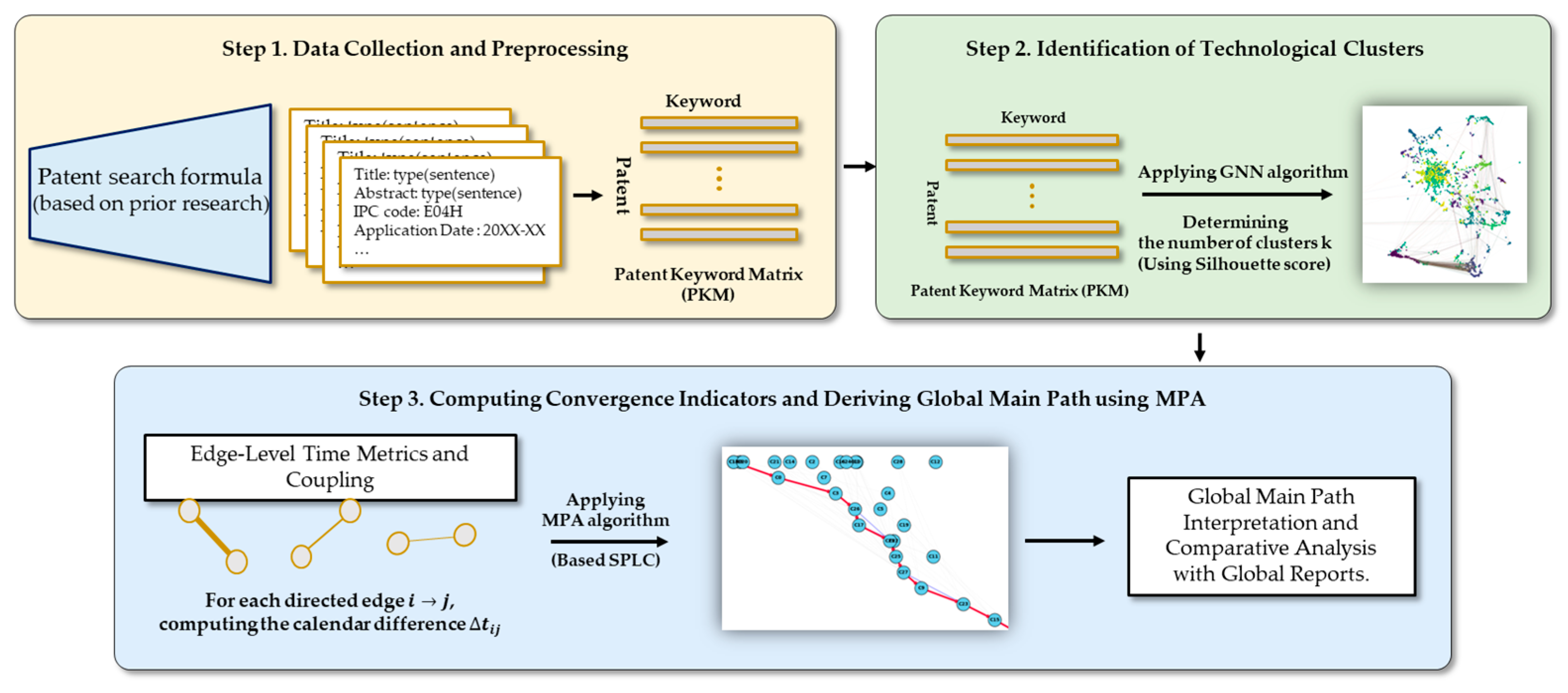
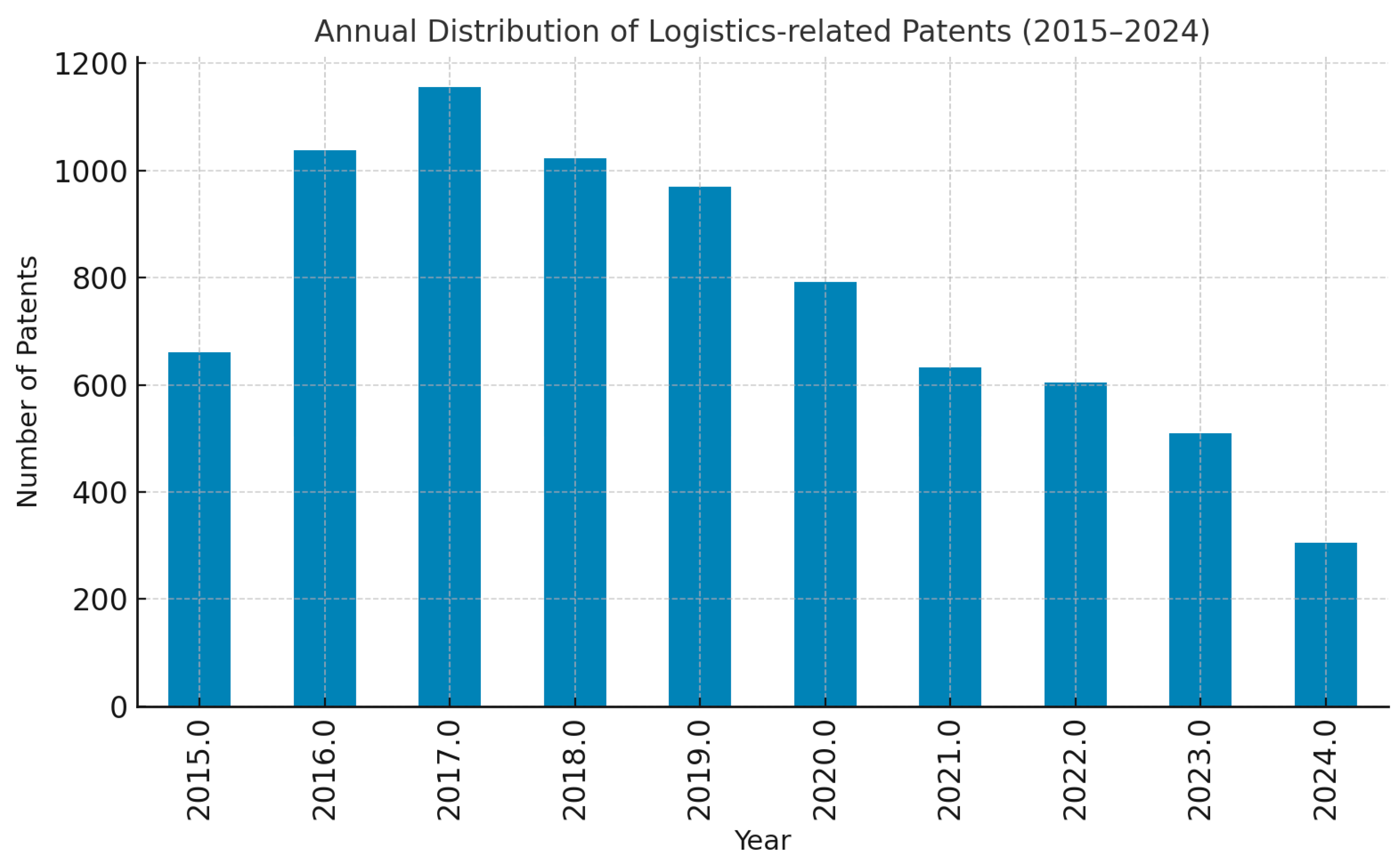
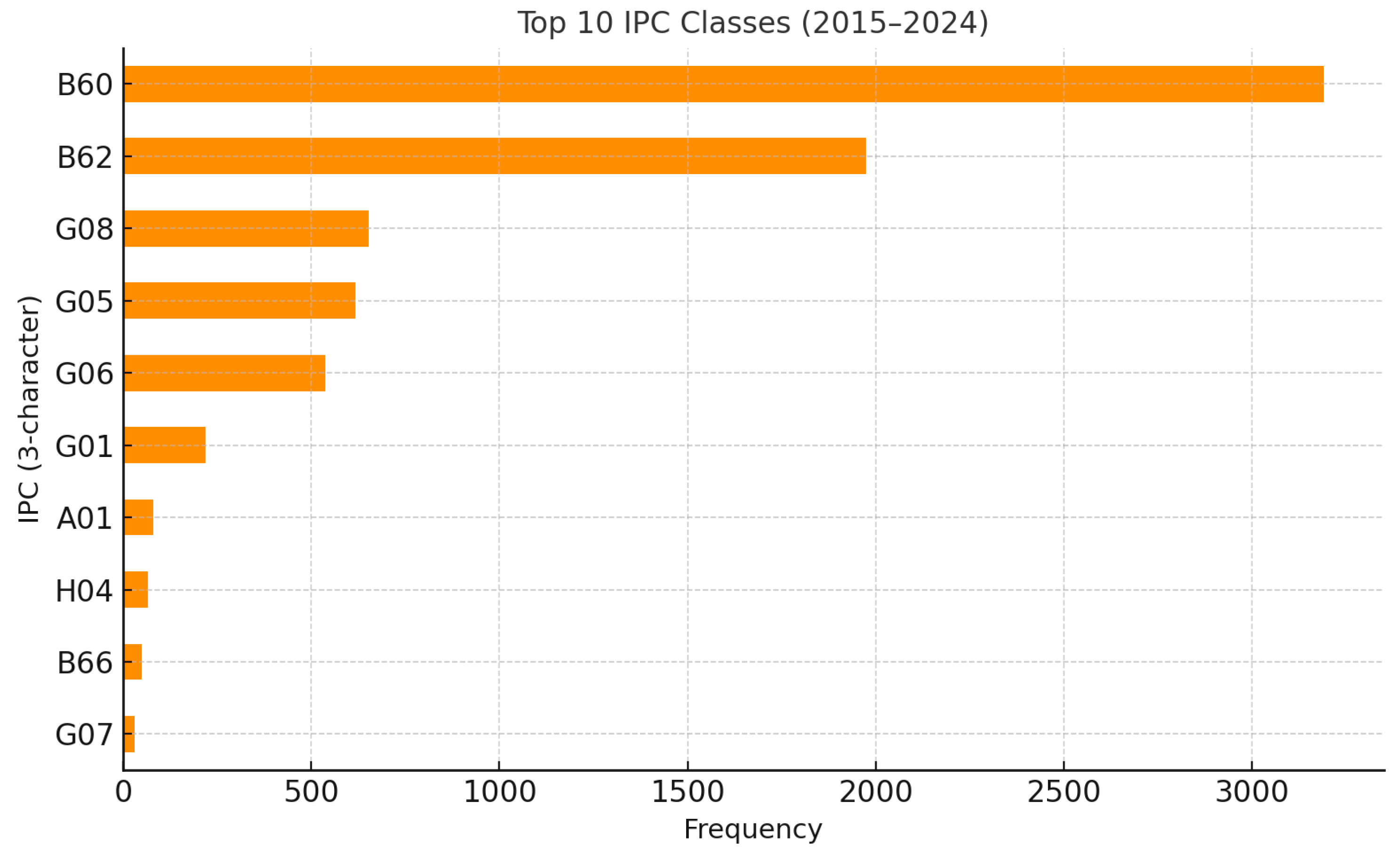
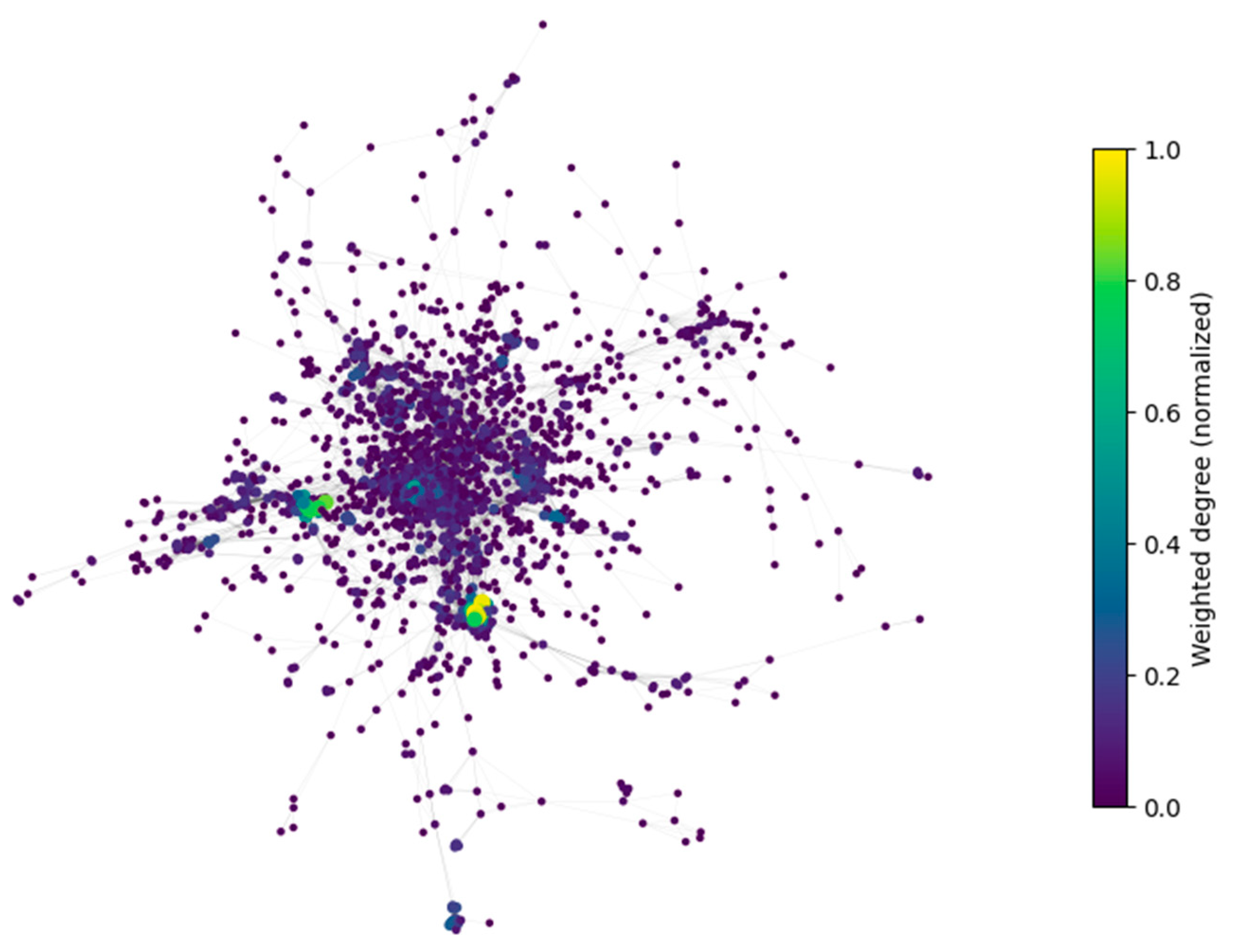
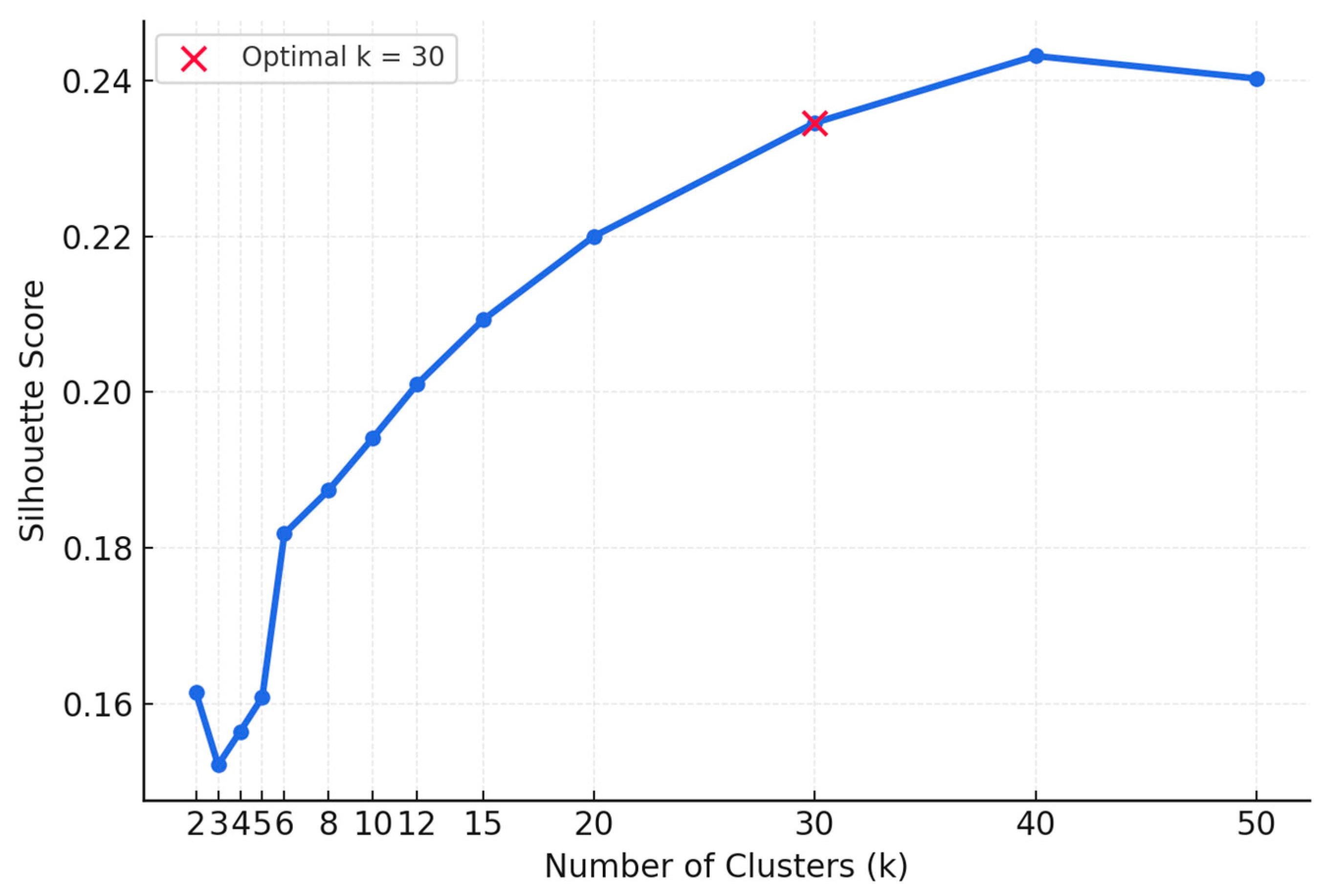
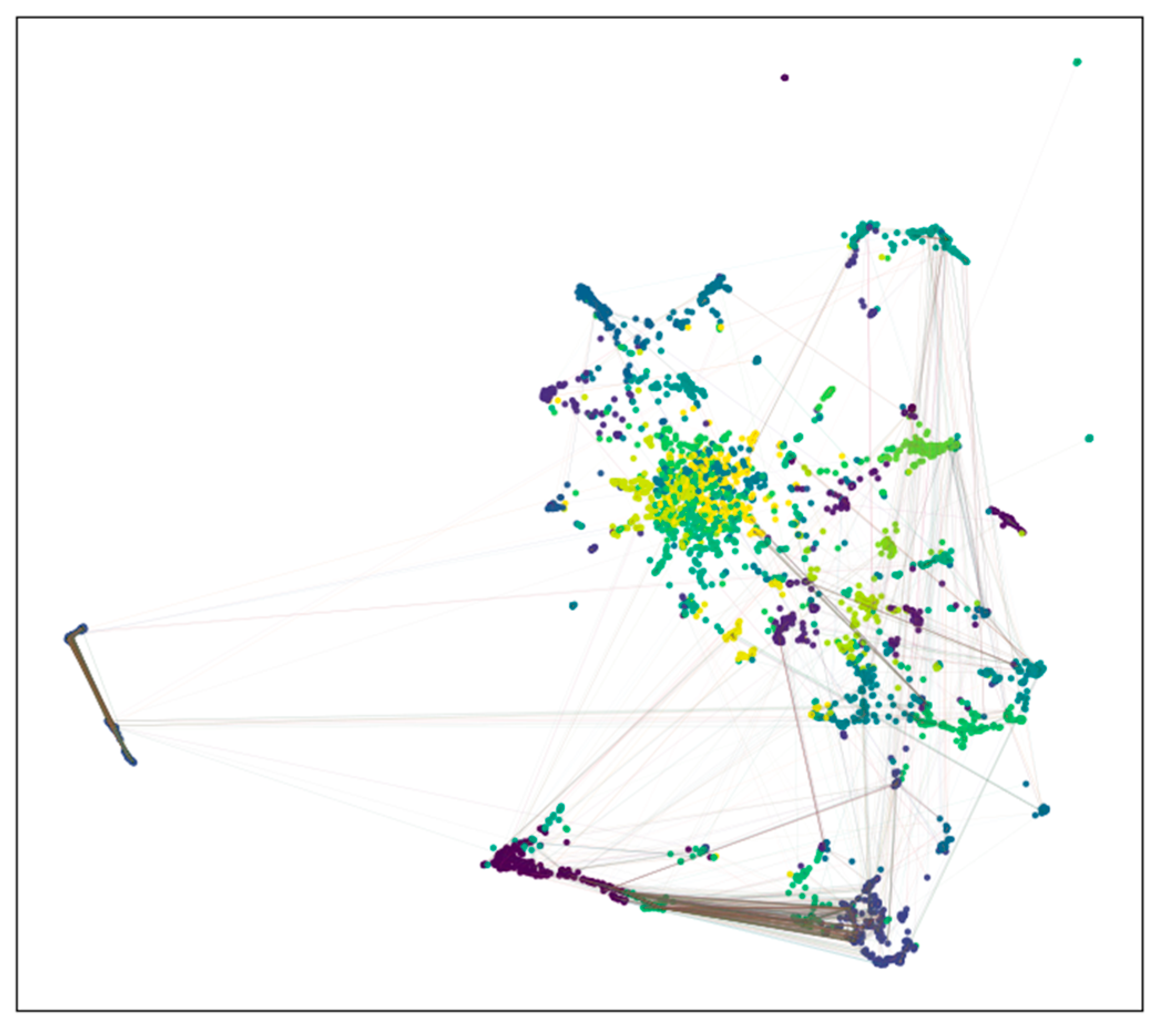
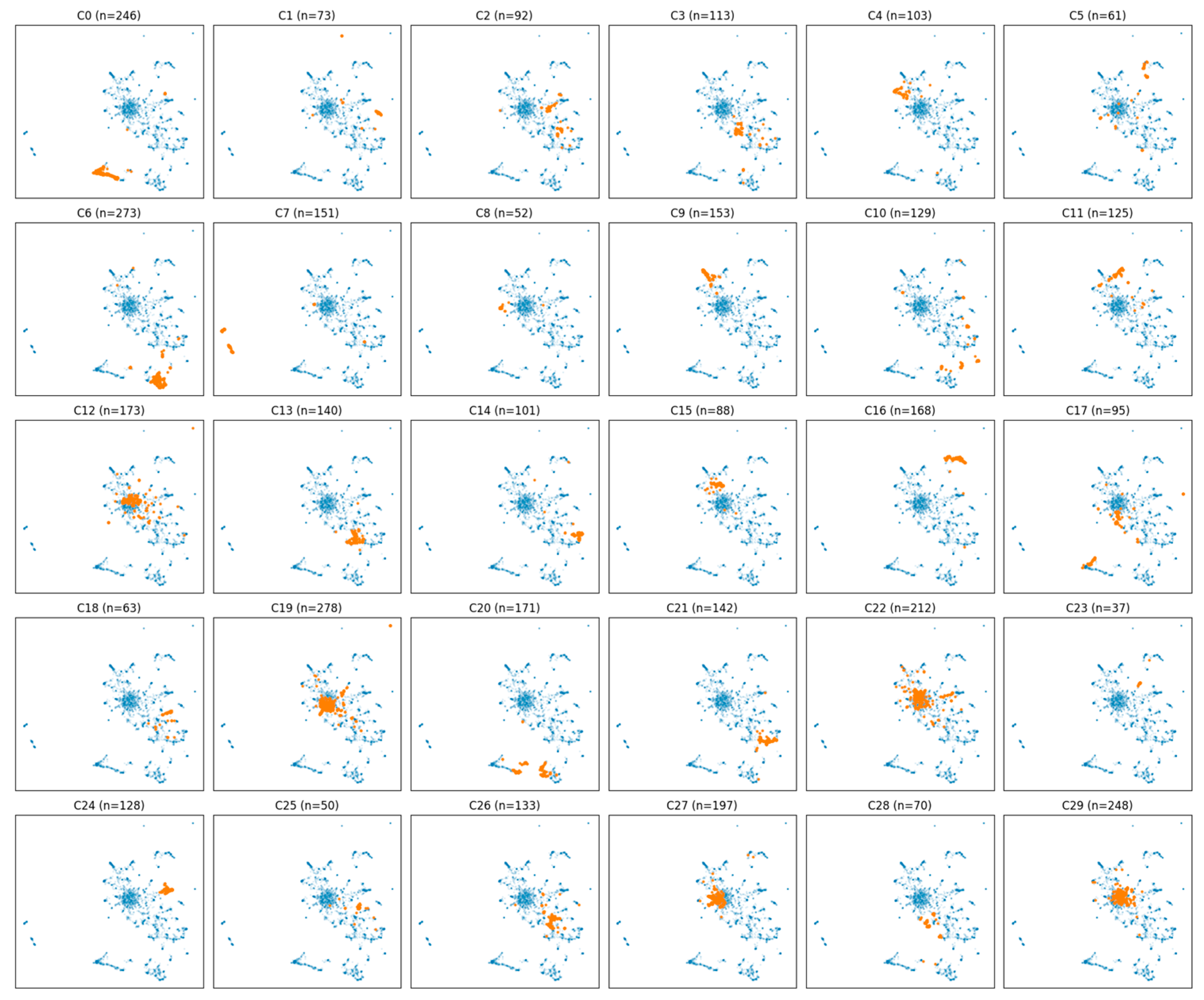
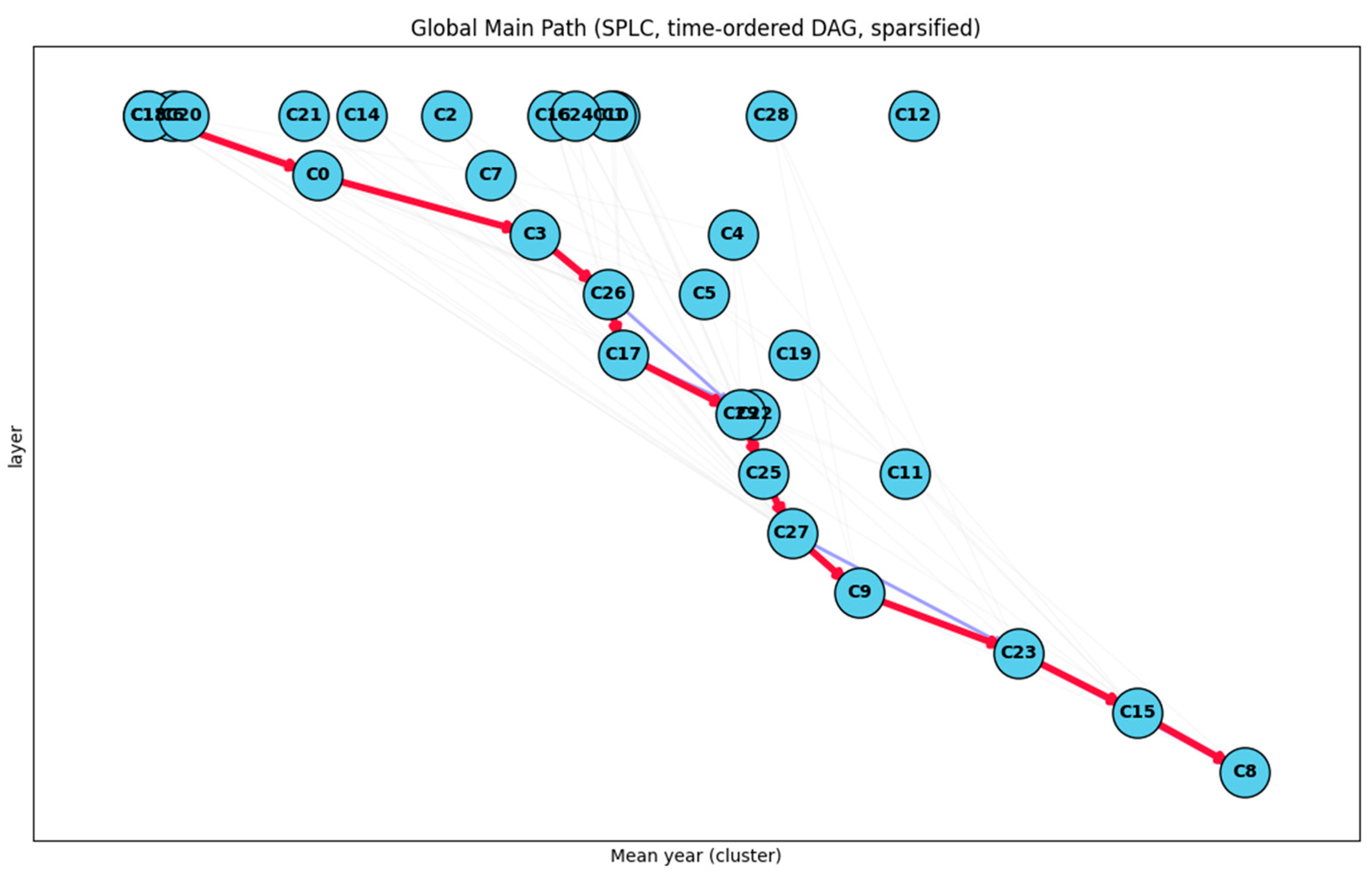
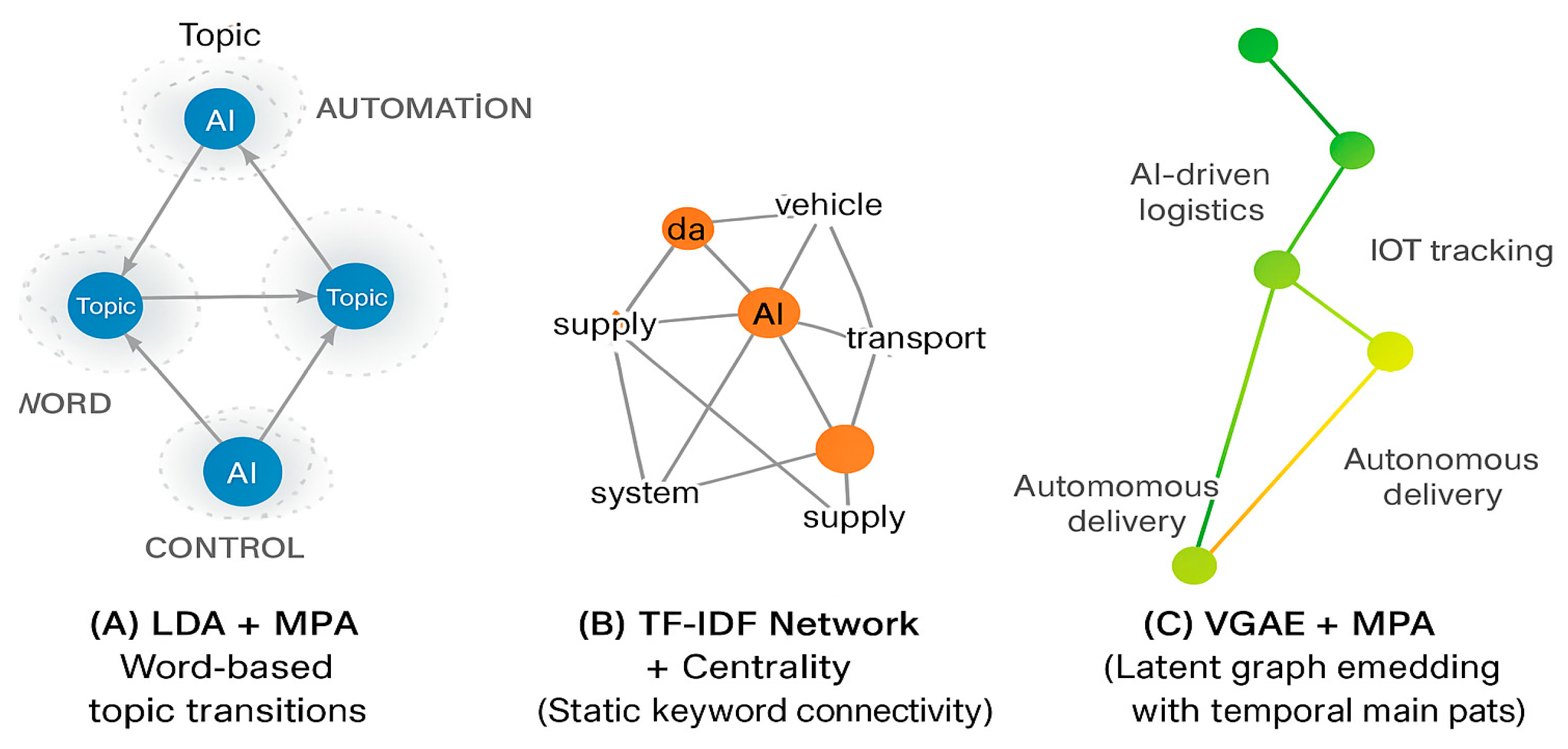
| IPC | 2015–2018 Share (%) | 2019–2024 Share (%) | Δ (pp) | Trend |
|---|---|---|---|---|
| B60 | 31.2 | 27.8 | −3.4 | ↓Slight decline |
| B62 | 24.5 | 23.1 | −1.4 | ↓ Minor |
| G05 | 14.8 | 15.9 | +1.1 | ↑ Slight increase |
| G06Q | 12.1 | 17.3 | +5.2 | ↑ Strong growth |
| H04W | 7.3 | 10.6 | +3.3 | ↑ Moderate growth |
| Indicator | Value |
|---|---|
| Total Patents | 4121 |
| Time Span | 2019–2024 |
| Unique IPC Classes | 46 |
| Unique Applicants | 2126 |
| Top IPCs | B60, B62, G05, G06, H04 |
| Model | Structural Coherence | Temporal Alignment | Interpretability |
|---|---|---|---|
| LDA + MPA | 0.42 | 0.36 | Limited (word-based similarity) |
| TF–IDF Network + Centrality | 0.47 | 0.40 | Moderate (static structure, no time flow) |
| VGAE + MPA (proposed) | 0.63 | 0.51 | High (integrated, temporally consistent) |
Disclaimer/Publisher’s Note: The statements, opinions and data contained in all publications are solely those of the individual author(s) and contributor(s) and not of MDPI and/or the editor(s). MDPI and/or the editor(s) disclaim responsibility for any injury to people or property resulting from any ideas, methods, instructions or products referred to in the content. |
© 2025 by the authors. Licensee MDPI, Basel, Switzerland. This article is an open access article distributed under the terms and conditions of the Creative Commons Attribution (CC BY) license (https://creativecommons.org/licenses/by/4.0/).
Share and Cite
Jun, S.; Lee, C.; Youn, S.J.; Lee, C. Technological Convergence and Innovation Pathways in Sustainable Logistics Systems: An Integrated Graph Neural Network and Main Path Analysis. Sustainability 2025, 17, 10507. https://doi.org/10.3390/su172310507
Jun S, Lee C, Youn SJ, Lee C. Technological Convergence and Innovation Pathways in Sustainable Logistics Systems: An Integrated Graph Neural Network and Main Path Analysis. Sustainability. 2025; 17(23):10507. https://doi.org/10.3390/su172310507
Chicago/Turabian StyleJun, Sungchan, Choongheon Lee, Seok Jin Youn, and Chulung Lee. 2025. "Technological Convergence and Innovation Pathways in Sustainable Logistics Systems: An Integrated Graph Neural Network and Main Path Analysis" Sustainability 17, no. 23: 10507. https://doi.org/10.3390/su172310507
APA StyleJun, S., Lee, C., Youn, S. J., & Lee, C. (2025). Technological Convergence and Innovation Pathways in Sustainable Logistics Systems: An Integrated Graph Neural Network and Main Path Analysis. Sustainability, 17(23), 10507. https://doi.org/10.3390/su172310507







